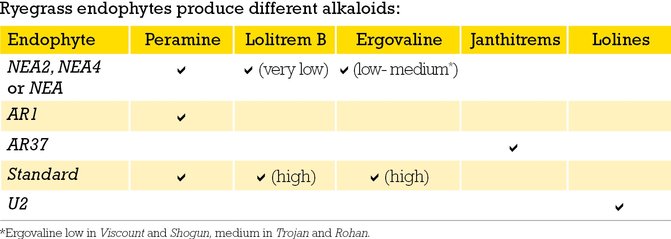Endophyte Alkaloids

Peramine
Peramine is an insecticide produced by some ryegrass endophytes and is believed to be the main alkaloid that gives control of pasture pests Argentine stem weevil and pasture mealy bug. It is not believed to have any adverse effect on animals.
Lolitrem B and ryegrass staggers
Lolitrem B is the alkaloid produced by Standard endophyte, which causes ryegrass staggers in livestock, also known as summer staggers. Ryegrass Without endophyte, or with AR1 endophyte produce no lolitrem B, so stock grazing these are safe from staggers.

NEA2, NEA4 and NEA endophytes provide ryegrass staggers free pasture for dairy cows and beef cattle. We have never seen staggers on commercial sheep farms. However, in an extreme situation, (i.e. summer drought, and/or where animals are forced to graze very close to the ground), a low level of staggers might be seen with sheep or deer.
Stock grazing ryegrass with Standard endophyte are most likely to suffer staggers when grazing the base of plants in dry summers or grazing the first green growth following a dry period. This is because lolitrem
B is concentrated in the base of the plant (see graph). Lolitrem B is also found in seed heads, so rank seedy pasture can also cause problems.
Staggers are seen as tremoring in mild cases and staggering in more severe cases.
Animals are very rarely killed directly by staggers, but may die through misadventure, such as drowning in streams.
Staggers cause severe management problems, particularly if stock must be regularly handled, e.g. milking cows.
Staggers usually clear up within 1-2 days if stock are given a diet containing no lolitrem B.
Lolitrem B is very stable in hay or silage so care should be taken in purchasing these if made from Standard endophyte pasture.
Ergovaline
NEA2, NEA4 and NEA endophytes produce low-moderate levels of ergovaline, which are believed to have no significant effect on animal performance or health. Ergovaline gives plants good control of black beetle, and moderate control of root aphid.
Animal trials on NEA2 endophyte, which produces levels of ergovaline about 50% of Standard endophyte, have shown the same lamb growth as those on the same ryegrass Without endophyte.

Trial work suggests that the ergovaline intake of dairy cows grazing well managed
NEA2-based ryegrass pastures is unlikely to affect animal health or production. Calculated animal ergovaline intakes, as graphed below, were below 0.03 mg/kg LW0.75/ day for diploid NEA2 pastures, at which levels adverse animal effects have not been measured.
Calculated ergovaline intakes of cows grazing pastures containing Standard endophyte were almost double NEA2 (below), at which level ergovaline effects could possibly be seen. However, in practice these are hard to separate from the more dramatic effects of lolitrem B also produced by Standard endophyte.

Janthitrem
Janthitrems are alkaloids produced only by AR37 endophyte. AR37 produces no peramine, lolitrem B or ergovaline.
Janthitrem levels follow the seasonal pattern of other alkaloids, low in winter and high in summer, and give a wide spectrum of insect resistance. Janthitrems have an effect on animal health, although less than the old Standard endophyte (SE).
In AgResearch lamb LWG trials ryegrasses with AR37 have usually shown similar LWG to AR1 endophyte, significantly better than SE. However AR37 can cause ryegrass staggers in sheep typically in summer dry situations; this can be severe and during these periods LWG will be reduced.
In endophyte trials run by DairyNZ no ryegrass staggers have been seen in dairy cows grazing AR37. Over the whole season MS production was similar for AR37 and AR1.
Lolines
Lolines are alkaloids produced by meadow fescue endophyte (Neotyphodium uncinatum), and give a wide spectrum of insect resistance. They are produced at good levels in meadow fescue plants, but when these endophytes have been put into perennial ryegrass cultivars loline levels are typically much lower.
They are also translocated to the roots of the plant so can assist in deterring root feeding insects.
While meadow fescues with loline producing endophytes have good insect control, they are typically slow to establish, low yielding, and have limited cool season growth.

